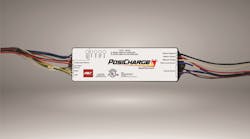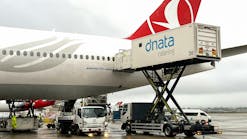Make the Most of GSE Fleet Management
When it comes to ground support equipment, fleet management practices have evolved over the years.
Acquisition options, vehicle technologies and maintenance practices and tools have all shaped the way companies look at the GSE in their fleets.
“We’ve gotten a lot smarter,” says Steve Leonard, senior vice president at PrimeFlight Aviation Services. “I think back to the beginning of my career. You would kind of put a piece of equipment out there, and it seemed to me like it never got paid much attention to.”
Now, equipment is treated – as it should be – like a valuable asset to help make ground handling operations more efficient.
“The industry has changed so much that you have to watch every particular portion of your operation from a cost management standpoint,” Leonard says. “Making sure that preventive maintenance checks are done completely – all of those kinds of activities, right down to fluid level management, makes such a huge difference.
Building a Fleet
In order to make the best decision regarding equipment acquisition, ground handlers and service providers should consider the length of their contract with a customer as well as the size of the station they’re operating at.
If a contract term is set for a longer period of time, or if the operating site is larger, purchasing equipment may be more attractive than leasing.
Similarly, explains Peter Stearn, vice president at Fortbrand Services, the size of the ground handling company matters too.
“If the ground handler is a nationwide provider, then they might be more inclined to purchase because if they lose a contract in Station A, they can redeploy that equipment to Station B,” Stearn says.
Shorter contracts or limited capital capabilities may steer ground handlers toward leasing equipment.
“They can match the term of the lease to the term of their contract with their customer, and keep their upfront cash requirements to a minimum,” Stearn says. “That way if they lose the contract at the end of the term, they are not obligated to keep the equipment. They can return it to the lessor.”
A similar line of thinking can be used when determining whether to acquire new, used or refurbished equipment. Ground handling companies can weigh the size of their budget with the length of time the GSE is needed and the location where it will be used.
William Long, president at Xcēd Aviation Services explains making that decision between new, used or refurbished GSE is no longer simply an economical choice.
“Today the ground handler’s decision is more related to the choice of the service provider,” he says. “Bottom line, flexibility and the scope of services are the key elements driving that decision today. It is no longer a pure financial decision.”
Ground handling companies also may find that having access to trade-in and refurb options adds further flexibility to their operations.
In addition to the financial impact on the company, PrimeFlight’s Leonard says it is crucial to establish what tasks a piece of GSE will be required to perform, so that an accurate request for proposal (RFP) can be drawn up.
Once quotes are received, he suggests weighing the competitiveness of pricing, warranty options and previous real-world experience with that type of equipment.
“We might even take the step of going to visit the company if they have a new piece of equipment that we think could be really good for us – just to be sure we put our hands on this asset that becomes critical in an airport operation,” Leonard explains.
Maintaining a Fleet
Similar to acquisition decisions, several factors can help determine the proper size of a GSE fleet, according to Bill Brooks, vice president of operations at Xcēd Aviation Services. Questions to consider may include:
- How many flights will be serviced, and how many flights will be handled at once?
- How far will bags be traveling?
- Are there peaks and valleys in the schedule?
- Will there be enough equipment to handle aircraft at peak times?
- Have spares been factored in for each equipment type to cover for scheduled and unscheduled maintenance?
Factoring how frequently a specific piece of equipment is used is also crucial to properly managing a GSE fleet.
Baggage tractors and conveyors are used constantly, endure the most wear and tear and require more preventative maintenance. Whereas pushbacks or air starts may see a lower duty cycle.
Frequently used equipment may require more unexpected repairs or need to be replaced sooner.
Seasonal equipment can pose challenges as well. Aircraft deicers, for example, can sometimes be difficult to manage because they are specialized and used only during cold months of the year.
“You need to have good training to maintain and keep on top of them,” Stearn of Fortbrand Services explains. “They’re only used seasonally, so that makes them more of a challenge because they tend to get forgotten when it’s summertime.”
Personnel turnover also can play a role in properly maintaining seasonal equipment. If new employees are not trained properly to use and maintain GSE, the equipment’s lifespan can be reduced.
Regardless of usage frequency, a GSE planning tool for normal maintenance cycles can help companies keep equipment in service and increase its lifecycle.
Leonard of PrimeFlight explains these tools can help adjust routine and preventative maintenance (PM) based on the location of equipment, noting GSE that is used in harsher, colder climates has different requirements than equipment operated in milder temperatures.
“The weather patterns in these locations really drive what you plan in terms of PMs and that frequency of PMs and the types of PMs that you complete,” Leonard says.
“The next step for us is always daily inspection,” he continues. “We know that this is the industrial side of the airline, and, like any sort of industrial equipment, things are going to wear out or they’re going to break in an unscheduled way.
“It’s important that we touch the equipment every day – sometimes a couple times of day, depending on the location – for things like fluid checks, fueling, tire pressure and those types of things.”
Leveraging Technology
The use of GPS tracking and computerized maintenance systems are making it easier for ground handlers and service providers to better manage their GSE fleets today.
“These have been around for some time, but now we see more of these units speaking to each other,” explains Xcēd’s Brooks. “Some GPS systems now download data directly to the maintenance systems. This allows maintenance technicians to spend more time turning wrenches rather than going around to each unit collecting data, such as hour meter readings.
“Also from an operator standpoint, we can now message drivers in real time to reroute them directly where they are needed,” he continues. “Daily operator checks can be done from a screen on the vehicle and automatically uploaded to the maintenance system. If defects are found, they can now email designated technicians who can respond quickly to increase uptime of all units.”
With GPS data logging systems that are currently available, fleet managers can see what each piece of equipment is doing and how it is performing for the entire life of that unit.
“Before this technology, we managed fleets by what we could physically see. Once a vehicle left our sight, all information on that vehicle was usually passed on through personnel driving the equipment,” says Brooks. “With current engine and drive train monitoring capabilities many functions can be monitored remotely to aid in timely repairs if a unit breaks.”
Additionally, Brooks points out that GPS data logging systems can help companies determine how long specific tasks should take.
“We can watch things like routing from aircraft to bag room, choke points along a route at certain times of day,” he says. “This allows us to plan better for more efficient service to the customer and save on maintenance, by completing the task without unnecessary hours being added to the unit’s run time.”
Decreased run times reduce the amount of required maintenance
Recalling the days of using physical sheets of paper, before the advent of computer spreadsheets, PrimeFlight’s Leonard says automated maintenance systems are often worth the investment.
“We can schedule out our preventive maintenance checks by piece of equipment and see how it has actually performed,” he says. “Based on that, we can get a pretty good idea if we’re being as effective as we want to be.”
Being able to track and compare a piece of equipment’s relative performance compared to other GSE units is valuable. With many options available, with varying features at a number of different price points, Leonard says it’s worth “kicking the tires” to see what automated management systems or other diagnostic tools work best for a specific service provider.
Tooling up
No matter if ground support equipment is new or used, ground handling companies must evaluate whether they can provide the proper level of maintenance in the station, says Xcēd’s Brooks.
“This is often the biggest and hardest problem to solve. I feel that the more training and tooling we give to the technicians in the field, the easier it becomes to get the life and performance we expect from the vehicle,” he says. “This also applies to the operators of the vehicles. The better trained the operators are, the less likely they will be to ask the vehicle to do something it was never designed to do. This will lead to a longer life and lower maintenance costs.”
Leonard of PrimeFlight notes that some maintenance may be outsourced if a ground service provider cannot perform certain tasks itself, or if it needs to increase productivity.
He suggests inquiring with maintenance facilities near a ground handling operation to learn if outsourcing routine repairs, unplanned fixes or other heavy work like an engine rebuild is a viable option.
End of Lifecycle
If planned equipment is being removed from service with increasing frequency, or if repair costs are mounting, it may be time to decommission that piece of GSE.
Brooks of Xcēd points out that the decision to replace equipment has always been a question of cost and timely completion. To determine if GSE should be replaced, ask:
- Will an engine and transmission be replaced with the same component, or will an upgrade be needed to meet emissions standards for the area the unit will be operating in?
- How old is the unit that requires repairs? Is the unit already 20 years old?
- Can the work be done locally, or will shipping charges be added to get it done elsewhere?
- What is the timeline for delivery of all parts and components? Does it fit the needed completion date?
- What is the warranty on new components versus the OEM warranty on new equipment?
- If the equipment is repaired or rebuilt, will it be suited to complete the service that it will be put into?
Reselling equipment being taken out of service may be an option for some companies. PrimeFlight’s Leonard says his company typically puts a six to nine year life cycle on a purchased piece of equipment with the hopes of reselling it to recoup some of the initial expense.
“We know that we can resell between those six to nine years at a pretty darn good rate,” PrimeFlight’s Leonard says. “Sometimes that calculation, that portion of the calculations, is something you give as much consideration as what the lease rates are.”
GSE Fleet Management Will Continue to Evolve
GSE fleet management has change significantly over the years and will continue to do so. New opportunities – electric/battery-powered ground support equipment, for example – may offer ground handlers an opportunity to decrease its operating costs.
Using sound practices to manage a fleet, and being opened to new possibilities, will help companies keep their fleets at peak operation.






